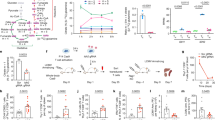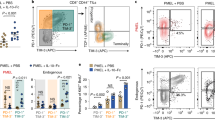Abstract
In response to antigen and costimulation, T cells undergo a series of metabolic transitions that fulfill the biosynthetic demands of clonal expansion, differentiation, and effector function. Following antigen clearance, the oxidation of long-chain fatty acids (LCFAO) has been implicated in the transition from effector to central memory T cells. However, studies demonstrating a role for LCFAO in memory T-cell development have largely relied on the use of etomoxir (ETO), a small molecule inhibitor of the long-chain fatty acid transporter CPT1A. Understanding how the depletion of nutrients including LCFA that might occur in tumor microenvironments affects T-cell proliferation, differentiation, and function has important implications for tumor immunotherapy. Here, we combine the analysis of posttranscriptional gene silencing with extracellular flux assays to determine if etomoxir exerts nonspecific effects on oxidative metabolism. The off-target effects of ETO that we describe highlight the challenges of using pharmacologic inhibitors in loss-of-function approaches in T cells.
Access this chapter
Tax calculation will be finalised at checkout
Purchases are for personal use only
Similar content being viewed by others
References
van der Windt GJ, O’Sullivan D, Everts B, Huang SC, Buck MD, Curtis JD, Chang CH, Smith AM, Ai T, Faubert B, Jones RG, Pearce EJ, Pearce EL (2013) CD8 memory T cells have a bioenergetic advantage that underlies their rapid recall ability. Proc Natl Acad Sci U S A 110(35):14336–14341. https://doi.org/10.1073/pnas.1221740110
O’Sullivan D, van der Windt GJ, Huang SC, Curtis JD, Chang CH, Buck MD, Qiu J, Smith AM, Lam WY, Di Plato LM, Hsu FF, Birnbaum MJ, Pearce EJ, Pearce EL (2014) Memory CD8(+) T cells use cell-intrinsic lipolysis to support the metabolic programming necessary for development. Immunity 41(1):75–88. https://doi.org/10.1016/j.immuni.2014.06.005
Pearce EL, Walsh MC, Cejas PJ, Harms GM, Shen H, Wang LS, Jones RG, Choi Y (2009) Enhancing CD8 T-cell memory by modulating fatty acid metabolism. Nature 460(7251):103–107. https://doi.org/10.1038/nature08097
O’Connor RS, Guo L, Ghassemi S, Snyder NW, Worth AJ, Weng L, Kam Y, Philipson B, Trefely S, Nunez-Cruz S, Blair IA, June CH, Milone MC (2018) The CPT1a inhibitor, etomoxir induces severe oxidative stress at commonly used concentrations. Sci Rep 8(1):6289. https://doi.org/10.1038/s41598-018-24676-6
Raud B, Roy DG, Divakaruni AS, Tarasenko TN, Franke R, Ma EH, Samborska B, Hsieh WY, Wong AH, Stuve P, Arnold-Schrauf C, Guderian M, Lochner M, Rampertaap S, Romito K, Monsale J, Bronstrup M, Bensinger SJ, Murphy AN, McGuire PJ, Jones RG, Sparwasser T, Berod L (2018) Etomoxir actions on regulatory and memory T cells are independent of Cpt1a-mediated fatty acid oxidation. Cell Metab 28(3):504–515. https://doi.org/10.1016/j.cmet.2018.06.002
Huang SC, Everts B, Ivanova Y, O’Sullivan D, Nascimento M, Smith AM, Beatty W, Love-Gregory L, Lam WY, O’Neill CM, Yan C, Du H, Abumrad NA, Urban JF Jr, Artyomov MN, Pearce EL, Pearce EJ (2014) Cell-intrinsic lysosomal lipolysis is essential for alternative activation of macrophages. Nat Immunol 15(9):846–855. https://doi.org/10.1038/ni.2956
Divakaruni AS, Hsieh WY, Minarrieta L, Duong TN, Kim KKO, Desousa BR, Andreyev AY, Bowman CE, Caradonna K, Dranka BP, Ferrick DA, Liesa M, Stiles L, Rogers GW, Braas D, Ciaraldi TP, Wolfgang MJ, Sparwasser T, Berod L, Bensinger SJ, Murphy AN (2018) Etomoxir inhibits macrophage polarization by disrupting CoA homeostasis. Cell Metab 28(3):490–503. https://doi.org/10.1016/j.cmet.2018.06.001
Nomura M, Liu J, Rovira II, Gonzalez-Hurtado E, Lee J, Wolfgang MJ, Finkel T (2016) Fatty acid oxidation in macrophage polarization. Nat Immunol 17(3):216–217. https://doi.org/10.1038/ni.3366
Divakaruni AS, Rogers GW, Andreyev AY, Murphy AN (2016) 12.03: The CPT inhibitor etomoxir has an off-target effect on the nucleotide translocase and respiratory complex I. Biochim Biophys Acta 1857:e118
Milone MC, Fish JD, Carpenito C, Carroll RG, Binder GK, Teachey D, Samanta M, Lakhal M, Gloss B, Danet-Desnoyers G, Campana D, Riley JL, Grupp SA, June CH (2009) Chimeric receptors containing CD137 signal transduction domains mediate enhanced survival of T cells and increased antileukemic efficacy in vivo. Mol Ther 17(8):1453–1464. https://doi.org/10.1038/mt.2009.83
Acknowledgments
This work was supported by grants from the University of Pennsylvania-Novartis Alliance.
Author information
Authors and Affiliations
Corresponding author
Editor information
Editors and Affiliations
Rights and permissions
Copyright information
© 2020 Springer Science+Business Media, LLC, part of Springer Nature
About this protocol
Cite this protocol
O’Connor, R.S., Milone, M.C. (2020). Testing the Specificity of Compounds Designed to Inhibit CPT1A in T Cells. In: Katz, S., Rabinovich, P. (eds) Cell Reprogramming for Immunotherapy. Methods in Molecular Biology, vol 2097. Humana, New York, NY. https://doi.org/10.1007/978-1-0716-0203-4_5
Download citation
DOI: https://doi.org/10.1007/978-1-0716-0203-4_5
Published:
Publisher Name: Humana, New York, NY
Print ISBN: 978-1-0716-0202-7
Online ISBN: 978-1-0716-0203-4
eBook Packages: Springer Protocols




